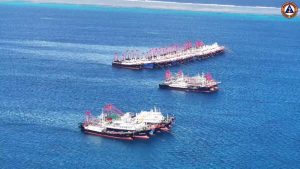In the latest sign of brewing trouble in the South China Sea, the Philippines has accused China of “swarming” a disputed reef off the coast of Palawan island.
The Philippine Coast Guard (PCG) said yesterday that one of its patrols had counted more than 135 Chinese vessels “dispersed and scattered” in the vicinity of Whitsun Reef, which lies within its 200-nautical-mile Exclusive Economic Zone (EEZ). The PCG described the significant deployment around the V-shaped reef, which Manila calls Julian Felipe Reef, as an “alarming development,” in light of recent frictions elsewhere in the South China Sea.
Whitsun Reef, the largest reef in Union Banks in the Spratly Islands, sits around 175 nautical miles off the coast of Palawan. Neither China nor the Philippines currently occupies the reef, but it is claimed by both countries, as well as by Vietnam.
In line with its recent policy of publicizing Chinese infractions, the PCG also released photos and videos of the Chinese vessels, some of which were arranged side by side in a long row – a practice known to maritime security analysts as “rafting.”
According to the statement, the PCG initially observed a deployment of around 111 Chinese maritime militia vessels in the vicinity of Whitsun Reef on November 13. The PCG was then ordered to “carry out a maritime patrol to challenge and document the illegal presence” of the ships. Then, on Saturday, the PCG deployed two 44-meter vessels to conduct further patrols in the area. “No response was made to the radio challenges issued by the PCG to the CMM vessels, which is now estimated to have grown to more than 135 vessels dispersed and scattered within Julian Felipe Reef,” the PCG said in its statement.
In its statement, the PCG added that it “maintains its unwavering commitment to safeguarding maritime security, safety and the marine environment in the course of protecting the territorial integrity, sovereignty, sovereign rights, and jurisdiction of the Philippines in the West Philippine Sea.”
Whitsun Reef is just the latest flashpoint for the growing tensions between the Philippines and China, which claims large parts of the Philippines’ SEZ under its maximalist “nine-dash line” claim. Much of the recent friction has surrounded Philippine-occupied Second Thomas Shoal in the Spratly Islands, around 100 kilometers to the east of Whitsun Reef, where Manila maintains a small contingent of troops aboard the BRP Sierra Madre, a now-decrepit warship that was grounded on the shoal in 1999.
This year, Chinese vessels have attempted on several occasions and with varying degrees of force to impede the Philippine resupply of its contingent of troops stationed aboard the Sierra Madre. This has resulted in a number of confrontations, including one in October in which Chinese vessels collided with a Philippine supply ship and navy vessel. Chinese vessels have also used high-powered water cannons and a military-grade laser to drive away Philippine supply flotillas since the start of 2023. The persistent Chinese pressure raised fears that when the Sierra Madre eventually disintegrates and collapses into the sea – which is a nearly foregone conclusion given the constant battering of acidic sea winds – Chinese vessels will swoop in and establish their de facto control of the shoal.
In recent months, Chinese vessels have also blocked Filipino fishermen from entering the fish-rich lagoon of Scarborough Shoal, a Chinese-occupied feature less than 200 kilometers due west of the Philippines’ Luzon island.
The natural outcome of this aggressive Chinese approach has been to fortify the Philippines’ security ties with partners that share its concerns about Beijing’s growing maritime claims and increasingly assertive attempts to assert and defend them. The primary partner, of course, is the United States, its long-time security ally, which has on several occasions recently stated that it is treaty-bound to come to the Philippines’ aid in the event of any attack on its forces in the South China Sea.
The Philippines has expanded U.S. access to Philippine military facilities under the 2014 Enhanced Defense Cooperation Agreement, and last month held joint patrols in its waters with the U.S., followed shortly after by a similar joint patrol with Australia. Under Marcos, the Philippines has also pledged to deepen its defense relationship with Japan, which has its own suite of maritime and territorial disputes with China.
China has so far responded to this security cooperation by doubling down on its claims, increasing its own deployments of coast guard and maritime militia vessels in order to increase the pressure on Philippine-held features lying within its “nine-dash line” claim. Where this security dilemma ends up is hard to foresee, but despite China and the Association of Southeast Asian Nations (ASEAN)’s announcement that it will speed up negotiations on a Code of Conduct for the South China Sea, none of the trend lines are good.

































